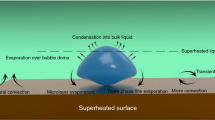Abstract
Condensing of a sugar–water solution is a widely used production process, especially in food industry. In this study, boiling temperature and heat transfer of different concentration levels of sugar/water solution is experimentally studied. In the experiment, the pool boiling with constant temperature difference between surface and boiling temperature is investigated. Boiling point of sugar/water solution depends on sugar mass concentration and on vapor phase pressure. A function is suggested to calculation the boiling temperature. The experimental data and the calculated values of boiling temperature are compared. The results are verified with previous investigations. It is determined that the heat flux between surface and sugar/water solution while pool boiling displays a linear relation with water mass concentration in the solution. Heat transfer coefficient could be determined in dependency of surface temperature and sugar mass concentration. Furthermore a function is suggested to predict the heat flux for engineering purpose, which is already used in similar form for pure substances.








Similar content being viewed by others
Abbreviations
- A :
-
surface area, [m2]
- c :
-
concentration, [kg/kg]
- c p :
-
constant pressure specific heat, [kJ/kg K]
- C :
-
consant
- g :
-
gravity, [m/s2]
- h :
-
heat transfer coefficient, [W/(m2 K)]
- h :
-
enthalpy, [kJ/kg]
- k :
-
coefficient, [kW/(m2°C1,3)]
- m :
-
mass, [kg]
- Pr :
-
Prandtl number
- q :
-
heat flux, [W/m2]
- Q :
-
heat, [kJ]
- T :
-
temperature, [°C]
- t :
-
time, [s]
- ρ :
-
density, [kg/m3]
- σ :
-
surface tension, [N/m2]
- μ :
-
kinematics viscosity, [kg/m s]
- b:
-
boiling
- f:
-
fluid
- g :
-
vapor, gas
- fg:
-
difference in property between saturated liquid and saturated vapor
- h:
-
heating
- l:
-
lost
- p:
-
pressure
- s:
-
sugar
- sat:
-
saturation
- t:
-
total
- w :
-
surface, wall
- wt:
-
water
- 1:
-
initial
- 2:
-
final
- n :
-
constant
- S :
-
Rohsenow consant
References
Holven AL (1936) Sucrose solutions: influence of pressure on boiling point elevation. Ind Eng Chem 28(4):452–455
Peres AM, Macedo EA (1997) A modified UNIFAC model for the calculation of thermodynamic properties of aqueous and non-aqueous solutions containing sugar. Fluid Phase Equilib 139:47–74
Kays WM, ME Crawford, Weigand B (2005) Convective heat and mass transfer, 4th edn. McGraw-Hill Higher Education, Boston
Rohsenow WM (1952) A Method of correlating heat transfer data for surface boiling of liquids. Trans ASME 74:969–976
Nukiyama S (1934) The maximum and minimum values of heat Q transmitted from metal to boiling water under atmospheric pressure. J Jpn Soc Mech Eng 37:367–374 (Translated in Int. J. Heat Mass Transfer 9 (1966) 1419–1433)
Kılıç M, Yiğit A (2004) Isı Transferi. Alfa
Hahne E, Barthau G (2006) Heat transfer and nucleation in pool-boiling. Int J Therm Sci 45:209–216
Kim JH, You SM, Pak JY (2006) Effects of heater size and working fluids on nucleate boiling heat transfer. Int J Heat Mass Transf 49:122–131
Kotthoff S, Gorenflo D, Danger E, Luke A (2006) Heat transfer and bubble formation in pool boiling: effect of basic surface modifications for heat transfer enhancement. Int J Therm Sci 45:217–236
Chen Y, Groll M, Mertz R, Kulenovic R (2005) Visualization and mechanisms of pool boiling of propane, isobutane and their mixtures on enhanced tubes with reentrant channels. Int J Heat Mass Transf 48:2516–2528
Choon NK, Chakraborty A, Aye SM, Xiaolin W (2006) New pool boiling data for water with copper-foam metal at sub-atmospheric pressures: experiments and correlation. Appl Therm Eng 26:1286–1290
Hagen KD (1999) Heat transfer with application. Prentice-Hall, Englewood Cliffs
Incropera FP, Dewitt DP (2002) Fundamental of heat and mass transfer, 5th edn. Wiley, NewYork
Jeschar R, Alt R, Specht E (1990) Grundlagen der Warmeübertragung. Goslar
Stephan K, Preusser B (1979) Warmeübergang und maximale Warmestromdichte beim Behaltersieden binarer und ternarer Flüssigkeitsgemische. Chem Ing.Tech 51:37, (Synopse MS 649/79)
Kutateladze SS (1959) Kritisce Warmestromdichte bei einer unterkühlten Flüssigkeitsströmung. Energetica 7:229–239 und ızv. Akad.Nauk Otd. Tekh. Nauk 4 1951,529
Bubnik Z, Kadlec P, Urban D, Bruhns M (1995) Sugar Technologists manual chemical and physical data for sugar manufacturers and users, 8th edn. Formerly Zuckertechniker-Taschenbuch (available on http://www.sugartech.com)
Author information
Authors and Affiliations
Corresponding author
Rights and permissions
About this article
Cite this article
Özdemir, M., Pehlivan, H. Prediction of the boiling temperature and heat flux in sugar–water solutions under pool-boiling conditions. Heat Mass Transfer 44, 827–833 (2008). https://doi.org/10.1007/s00231-007-0310-3
Received:
Accepted:
Published:
Issue Date:
DOI: https://doi.org/10.1007/s00231-007-0310-3




